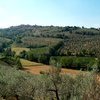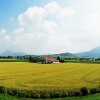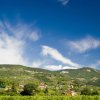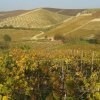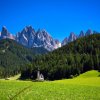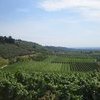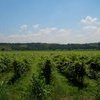Valpolicella: a tour of cellars, museums and villas
Departure from: Sant'Anna D'Alfaedo
Arrival to: Negrar
What you can taste:
Amarone della Valpolicella, Amarone della Valpolicella Classico, Recioto della Valpolicella, Recioto della Valpolicella Classico, Valpolicella, Valpolicella Classico, Valpolicella Classico Superiore, Valpolicella Classico Superiore Ripasso, Valpolicella Superiore, Valpolicella Superiore Ripasso
Itinerary details
Valpolicella is located north-west of Verona, nestled between the capital, a city of art, a UNESCO heritage site, Garda and the Adige.
Its territory, which extends for 240 sq km, borders on Lake Garda to the west, while to the east and north, it looks to the Lessini Mountains and develops in the hills at the foot of the Veronese Pre-Alps.
Valpolicella, therefore, is enclosed between the Valdadige, Lessinia and the Veronese plain, a stone's throw from Lake Garda.
The landscape of the Valpolicella, predominantly hilly, is extremely varied morphologically, ideally, it looks like a fan of valleys that branch off from Verona, a slide of the Lessina mountains towards hills and plains.
It includes seven municipalities, all belonging to the province of Verona: Sant'Ambrogio di Valpolicella, Fumane, Sant'Anna d'Alfaedo, Negrar, San Pietro in Cariano, Marano di Valpolicella and Pescantina.
Everywhere, in Valpolicella, it is possible to observe vineyards, interspersed with olive and cherry trees.
The geological and climatic characteristics of the area are, in fact, the basis of the typicality of the local wines, produced following traditional techniques, but without ever forgetting innovation and respect for the environment. The transition to modern crops, in fact, took place without completely erasing the signs of traditional agriculture.
Valpolicella has been renowned, since the times of ancient Rome, for its viticulture and, in particular, for the Amarone wine.
Valpolicella, then, is a territory rich in typical quality products, from wines to food and wine, passing through agricultural products; here you can taste not only the excellent wines of Valpolicella, but also cheeses, such as Monte Veronese, Ricotta and cheeses with herbs and cured meats from Lessinia.
Also worth mentioning are the truffle, the extra virgin olive oil and the honey.
The tasting of cherries, kiwis and princely peaches is a must.
Valpolicella, however, is not only splendid landscapes and evocative natural beauties that allow for splendid excursions and incredible itineraries with breathtaking views, but also architectural sites of immense cultural and artistic value, as evidenced by the villages, churches and Venetian-style villas that enrich the area with evidence of years of history.
Historical monuments of great attraction are the palaces and stately villas of Valpolicella.
Especially during the period of domination of the Serenissima Republic of Venice, large land holdings were formed: the manor houses were transformed into sumptuous villas, decorated by the best artists, the scene of aristocratic and intellectual salons.
There are also numerous religious artistic testimonies, but also of popular and rural architecture, a heritage made up of districts, courtyards, dovecote towers, vaults, capitals and fountains, dry stone walls, created with such technical skill as to translate even the work in fields.
Furthermore, Valpolicella also has numerous archaeological sites that can be visited which testify to the human presence in Valpolicella from the Stone Age. Finds and artifacts, as well as settlements of immense value, which date back to 115,000 years ago, will take you on a journey into the history of our ancestors, from Neanderthal man to Homo Sapiens.
Nature and archaeological sites in Valpolicella
Our itinerary in Valpolicella starts from Sant'Anna D'Alfaedo, a mountain municipality on the border between Valpolicella and Lessinia, which overlooks the three major valleys of Valpolicella, namely those of Negrar, Marano and Fumane, included in the Lessinia Regional Natural Park .
The Park, established in 1990, covers over 10,000 hectares on the Monti Lessini plateau and contains a surprising variety of naturalistic, historical and archaeological evidence of inestimable value, including all the Veronese mountains, except Monte Baldo.
For hiking enthusiasts, a climb to the Corno d'Aquilio is a must, from the top of which you can admire incredible views of the Val d'Adige, the whole of Lessinia, the Little Dolomites, Mount Baldo and Lake Garda. Of considerable naturalistic interest, near the summit of the Corno d'Aquilio, we find the Spluga della Preta, one of the deepest caves in the world, a karst abyss with wells of hundreds of meters that reach a depth of almost a thousand meters, 877 of which have been explored so far and numerous unexplored tunnels that attract expeditions of speleologists from all over the world.
Not far away, the Chiesetta degli Speleologi and, about 200 meters south-west of the Spluga de la Preta, opens the Grotta del Ciabattino and the Covolo di Camposilvano, which can be visited without particular precautions, while the Spluga de la Preta can only be approached by equipped experts.
Another masterpiece of nature is the Ponte di Veja, the largest bridge in Europe, a daily destination for visits by onlookers and naturalists and an authoritative prehistoric and biospeleological site; the bridge is a majestic natural arch of rock, formed thanks to the fall of the internal part of a large karst cave (covolo), in one of the phases of the last glaciation. Located at 602 m above sea level, numerous traces of the Paleolithic and of our ancestors have been found in it. The Veja bridge has been visited throughout history by illustrious characters: in fact, tradition has it that Dante Alighieri, in describing the Malebolge of hell, in the Divine Comedy, was inspired by this bridge, as well as Andrea Mantegna Mantua reproduced it, in the Palazzo Ducale, within the frescoes of the Camera degli Sposi.
Also in Sant'Anna d'Alfaedo there are fossil remains and, in fact, here is the Paleontological and Prehistoric Museum which collects archaeological and paleontological materials, linked to the territory, and incorporated in the layers of the Prun Stone, also known as the Lessinia Stone .
In Marano di Valpolicella, however, of the utmost interest is Monte Castelon, which stands dominant on the hilly ridge, between the valleys of Marano and Fumane, one of the most important archaeological areas in the whole of Valpolicella.
For those who love naturalistic itineraries, the excursion to the Tibetan Bridge is also a must, a bridge that connects the Valpolicella and Lessinia, running over the Valsorda, suspended 40 meters above sea level from the Rio Mondrago below, an extraordinary feat of engineering and the first construction of the generally in Veneto and among the few in Italy.
Of great naturalistic interest are also the Covoli di Marano di Valpolicella, Coalo del Diaolo and Buso Streto, two karst caves, rich in calcareous concretions, which can be reached by a suggestive route along meadows and woods, which can be traveled all year round, in full autonomy, but the visit inside the Covoli must be booked, and it is also possible to request the presence of a guide.
Continuing our itinerary, we come across the Municipality of Fumane, another site of great naturalistic interest; in fact, in the hamlet of Molina, in the middle of the natural park, and in that of Breonio, a few kilometers further on, there are very interesting itineraries to do on foot or by bike.
Breonio is the ideal starting point for excursions of various levels of difficulty, thanks to which you can admire breathtaking landscapes and enchanting views of Lake Garda, Monte Baldo, the Valdadige and the Venetian Pre-Alps and, on the clearest days, all the Apennines, up to Monviso.
Molina, on the other hand, is known for its Parco delle Cascate; if, in fact, once upon a time, the strength of the Progno torrent was the resource to set in motion the numerous mills, today, it creates marvelous and suggestive waterfalls, cascades and lakes, but also caves and sheer rocks, inside the naturalistic oasis di Molina, classified as a nature reserve area with an educational focus. To complete the charm and interest of the Park, there is the annexed Botanical Museum, in which all the plant species of the Lessinia Natural Park are classified.
Still on the subject of routes in contact with nature, from the center of the town, by bike or on foot, there is a path that leads to the Sanctuary of the Madonna de La Salette, built on a hill overlooking the town of Fumane. From there, you can enjoy a panoramic view of the entire valley and the Valpolicella.
A visit to the Grotta di Fumane, the Riparo Solinas, is also a must, a prehistoric site inhabited by the Neanderthals (Homo neanderthalensis) and by the so-called modern men (Homo sapiens). The cave preserves, among all the fragments of figurative art of the upper Paleolithic and an anthropomorphic figure, considered the oldest painting find in all of Europe, dating back to 35,000 years ago.
Not far from the center of Fumane, however, stands Villa Della Torre, a Renaissance villa on the slopes of a hill, conceived and built in harmony with the surrounding environment and with a perfect interpenetration between architecture and landscape. Today it is owned by the Allegrini farm, one of the most famous wine producers in Italy and a point of international excellence, especially as regards Amarone. Surrounded by the vineyard called Palazzo della Torre, from which the homonymous wine, famous throughout the world, is also produced, the villa is inextricably linked to the pleasure of food and wine; here, a guided tour of its vineyards, the cellar and the wine shop is not to be missed, with relative tasting, to savor and understand the excellent wines produced by the Allegrini family farm, combined with typical local products. Furthermore, in the Wine shop it is possible to purchase wines for tasting.
Art and History in Valpolicella
In Sant'Ambrogio, the Palazzo del Comune, which now houses the headquarters of the "Strada del Vino Valpolicella" association, is of notable artistic and cultural interest due to its spectacular marble staircase, central fountain, monument to the stonemason and frescoes.
Another jewel is Villa Brenzoni Bassani, headquarters of the Marble Fair Offices and owned by the municipality, now undergoing renovation and, therefore, can only be visited from the outside.
To visit, upon reservation, the Nichesola villas, dating back to the mid-1500s and Serego Alighieri, set among the hills of Gargagnago, where the descendants of Dante Alighieri acquired the first farms. The villa, a fascinating mosaic of styles from different eras, is surrounded by centuries-old vineyards and also has an ancient winemaking tradition. Here it is possible to visit the estate and have a wine tasting.
Also, near Gargagnano, the Health Path begins, an equipped path and ideal destination for lovers of outdoor fitness.
In the heart of San Giorgio, one of the most beautiful villages in Italy, an ancient religious center, there is also an ancient barbaric-Romanesque parish church dedicated to the homonymous saint.
Adjacent to the Pieve, on the northern side, is the suggestive 12th century cloister, and the small museum which houses numerous archaeological finds and an ethnographic section, where a typical Valpolicella house from past centuries has also been rebuilt.
In the locality of Monte, located in a strategic point at the entrance to the Vadadige, stands the majestic Forte Werk Mollinary which is part of the defensive complex built in local stone, under the skilful guidance of the Habsburg military architects and now a destination which allows you to enjoy one of the most beautiful views in Italy.
For those who love nature, the paths of Gargagnago are also unmissable, panoramic paths that wind through valleys, woods, vineyards, olive trees, cherry trees, and then springs, streams and ponds, designed "ad hoc" for relaxing walks.
Continuing the itinerary we reach Pescantina, a municipality strongly linked to water and famous for the cultivation of peach trees which play a fundamental role in the local economy.
Here, of notable historical interest, is the Monument to the Ex-Internees, a place of memory and monument in remembrance of the thousands of human lives who escaped death from the Nazi concentration camps and were rescued, in 1945-47, by the Pescantina volunteers.
In Pescantina, there is also the Ethnographic Museum called "Work and traditions along the river Adige", where the ancient activities of the town are documented, typical of all the populations who lived along the course of the river.
Also very interesting is the historical-naturalistic itinerary Strada Alzaia which runs along the Adige and which was once used for river transport and which has now become a destination to be traveled on foot, by bicycle or on horseback.
Of historical and cultural interest, on the other hand, is Villa Bertoldi, built during the 17th century and which now preserves rare volumes from the 17th and 18th centuries in the Library.
We then come to San Pietro in Cariano. Here, at the foot of Colle Castelrotto, stands Villa Giona-Fagiuoli, built towards the end of the 15th century, but remodeled over the following centuries, dedicated to theater and music festivals, such as the over ten-year festival of Musica in Villa. Now it is an excellent hotel that offers numerous services and, in the medieval tower, there is a wine shop where you can taste the wines of Valpolicella and the tasty products of the Veneto region.
Also of immense historical and cultural value is Villa Ottolini-Lebrecht, now the seat of the University of Oenologists and which can be visited from only during the week, compatibly with the course of studies.
As far as religious heritage is concerned, the Pieve di San Floriano should be mentioned.
In the hamlet of Pedemonte, on the other hand, stands Villa Serego known as Santa Sofia, on which Andrea Palladio also worked, in the second half of the 1500s, whose project was never fully completed; now, it is home to a farm for the production of wine. In the historic cellars, you can taste the classic Veronese and Valpolicella wines and, after the guided tour, you can also buy all the wines tasted in the Wine Shop.
Our itinerary concludes in Negrar, where, for lovers of Villas but also of Wine, a visit to Villa Mosconi is a must, an elegant monumental complex dedicated to the production of wines, with adjoining gardens and historic park, dating back to the 1700s. The villa , a unique architectural and landscape jewel can be visited and it is also possible to taste the wines of its production. Famous for its ancient winemaking activity which made it one of the major wineries in Northern Italy, it now continues the tradition of producing excellent wines. The classic Amarone della Valpolicella, dating back to 1936, was actually originated in the cellars of this villa due to a "mistake" by a cellarman who let a Recioto ferment more than it should. Furthermore, due to its historical and environmental value, the park of Villa Mosconi Bertani is listed among the eighty parks on the list of the Great Italian Gardens.
In Negrar we also find the Prun quarries, ancient underground marble quarries located in Monte Prun. Where once pink marble was excavated, to extract Prun stone or Lessinia stone, which then went on to adorn the main monuments of the Verona area, today an evocative path of a few kilometers has been created, between open-air quarries or dug in tunnels , with tunnels and caves; unfortunately, the area, due to lack of security, cannot be visited.
For lovers of walking and nature, but also of literature, it is worth taking the Sentieri Salgariani, paths dedicated to the writer Emilio Salgari and to the protagonists of his books; the three paths, red, orange and green are walks in the places where the artist loved to be inspired.
It is also worth a visit to Villa Guerrieri Rizzardi, built by the architect Luigi Trezza, one of the greatest exponents of Veronese and Venetian neoclassical architecture, owned by the Rizzardi Warriors who own vineyards and cellars in the classic areas of Verona, with 300 years of viticulture.
The related garden, the Pojega Garden, open only in the summer season, is one of the examples of an Italian garden, open for visits and wine and olive oil tastings.
Umbria • Montefalco
The hills of Sagrantino di Montefalco
Route distance: about 7 km
Suggested travel mode: by Bike
Veneto • Breganze - Bassano
The "Strada del Torcolato e dei vini di Breganze"
Route distance: about 40 km
Suggested travel mode: by Car
Veneto • Euganean Hills
Euganean Hills: the Park, the Villas and the Cellars
Route distance: about 70 km
Suggested travel mode: by Car
Veneto • Valpolicella
Valpolicella: a tour of cellars, museums and villas
Route distance: about 40 km
Suggested travel mode: by Car
Lombardy • the river Po
Visit Casalmaggiore on the trail of the pumpkin
Route distance: about 3km
Suggested travel mode: by Foot
Piedmont • Monferrato Astigiano
Monferrato Astigiano and tradition of Bagna Cauda
Route distance: about 30 km
Suggested travel mode: by Car
South Tyrol • St. Magdalene
Excursion to Val di Funes, tasting Speck Alto Adige
Route distance: about 40km
Suggested travel mode: by Foot
Emilia Romagna • Parma
Langhirano, along the Parma Ham Road
Route distance: about 50km
Suggested travel mode: by Car
Liguria • the coast
The Genoese coast and the Focaccia di Recco
Route distance: about 30 km
Suggested travel mode: by Foot
Lazio • Castelli Romani
Frascati and surroundings
Route distance: about 30km
Suggested travel mode: by Car
Veneto • the Castles
From the Castles of Romeo and Juliet to Soave
Route distance: about 35 km
Suggested travel mode: by Car
Veneto • natural wines
From the Euganean Hills to Montecchio Maggiore
Route distance: about
Suggested travel mode: by Car
Tuscany • Val di Cornia
Val di Cornia, in the footsteps of the Etruscans
Route distance: about 35 km
Suggested travel mode: by Car
Lazio • Colli Albani
The Castelli Romani of the Via Appia
Route distance: about 24 km
Suggested travel mode: by Car

